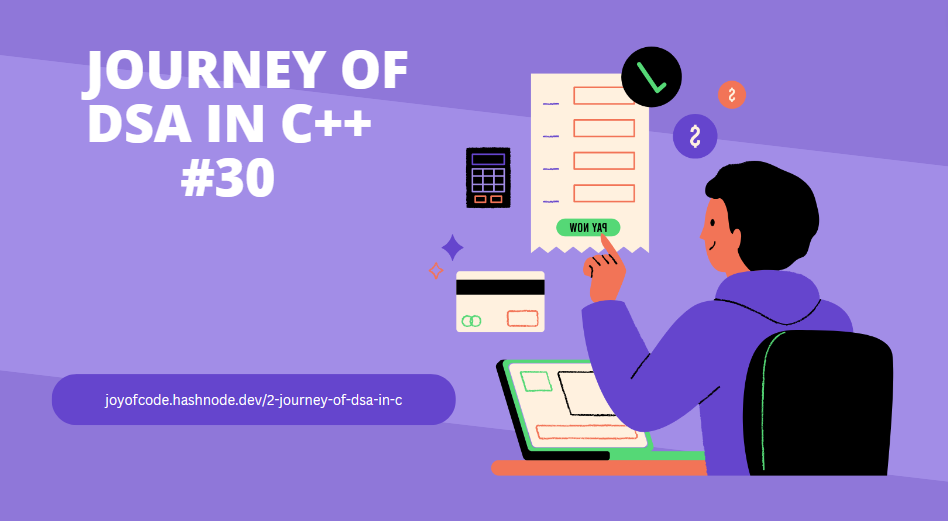#30. Journey to DSA to C++
 Joy Shree
Joy Shree
Greetings, dear readers! 👋
Today, I'm here to talk about a fundamental aspect of mastering Data Structures and Algorithms (DSA) - the art of problem-solving. It's not just about understanding theories and algorithms; it's about applying these concepts to solve real-world problems. In this article, I'll guide you through the process of practicing problem-solving across various DSA topics and the significance of self-assessment in your learning journey.
🎯 Unveiling the Power of Problem-Solving in DSA 🧩
Problem-solving in DSA isn't merely about finding the correct answer; it's about understanding the process and logic behind arriving at that solution. It's the key to mastering the intricacies of algorithms and data structures. Let's explore how you can strengthen your skills through practicing problems from various DSA topics.
1. Diverse Problem Selection:
Select problems from arrays, linked lists, trees, graphs, sorting, searching, and dynamic programming. Each category offers distinct challenges and helps in developing a well-rounded skill set. For instance, a problem in arrays might focus on manipulation, while a tree problem might involve traversal.
2. Apply Different Algorithms:
When faced with a problem, try various algorithms and data structures to solve it. For instance, while solving a searching problem, experiment with binary search, linear search, or even hashing to understand the best fit for that scenario.
3. Practice, Practice, Practice:
Consistent practice is the key to mastering problem-solving in DSA. Solve problems regularly, possibly a few problems every day, to keep your skills sharp. Platforms like LeetCode, HackerRank, or CodeSignal offer a plethora of problems to explore.
4. Self-Assessment and Reflection:
After solving a problem, it's crucial to review your solution. Analyze the time complexity, space complexity, and the elegance of your solution. Reflect on whether there might be more optimized ways to approach the problem.
🔍 Techniques for Effective Problem-Solving 🛠️
Let's delve into a basic problem-solving technique, say, finding the maximum element in an array. This is a simple problem, but it allows us to apply key concepts and techniques:
pythonCopy code# Python example of finding the maximum element in an array
def find_max(arr):
max_num = float('-inf')
for num in arr:
if num > max_num:
max_num = num
return max_num
In this example, we've employed a straightforward iteration through the array to find the maximum element. This helps reinforce the understanding of loops and comparisons.
📚 Reflecting on the Learnings
Our journey began with a quest to comprehend the essentials of DSA in C++. We delved into the depths of various data structures and algorithms, understanding their functionalities, implementations, and applications.
From arrays and linked lists to trees, graphs, and sorting algorithms, we've explored a diverse array of topics. The goal wasn't just to grasp these concepts but to absorb them, allowing us to solve real-world problems using efficient code written in C++.
We navigated through code snippets, grasped the significance of time and space complexities, and tinkered with practical implementations to fortify our understanding.
🌟 Highlights of the Journey
Understanding Data Structures: Exploring the characteristics of arrays, linked lists, stacks, queues, trees, and graphs, and comprehending their applications in different scenarios.
Algorithms Galore: From simple searching and sorting techniques to advanced graph algorithms and dynamic programming, each algorithm presented a unique challenge and learning opportunity.
Coding in C++: Mastering the art of applying these data structures and algorithms in C++, honing our coding skills to efficiently tackle problems.
🧩 Embracing the Journey's End
As we approach the culmination of this journey, it's essential to recognize the strides made and the knowledge accumulated. The power of problem-solving in C++ is now within our grasp, empowering us to analyze, strategize, and implement efficient solutions to complex problems.
🚀 Moving Forward
Even though this marks the end of our scheduled journey, it's not the end of the road for learning. The realm of DSA is vast, and there's always more to explore and discover.
As you bid farewell to this specific journey, I encourage you to keep the flame of curiosity burning. Seek out new challenges, continue practicing on platforms like LeetCode, HackerRank, or Codeforces, and participate in coding contests to keep your skills sharp.
And who knows, this might just be the start of a new adventure in more specialized domains of DSA, advanced algorithms, or even exploring other programming languages.
👏 Thank You!
A heartfelt thank you for embarking on this journey to DSA in C++ together. Your enthusiasm, dedication, and hunger for learning have made this journey an enriching experience.
As we bid adieu to this phase, remember - it's not just about the destination but the journey itself that shapes us into better programmers and problem solvers.
Keep coding, keep exploring, and keep learning. Farewell for now, but not forever!
Remember, the more you practice, the more confident you'll become in tackling diverse problems. 🚀🧠
Subscribe to my newsletter
Read articles from Joy Shree directly inside your inbox. Subscribe to the newsletter, and don't miss out.
Written by

Joy Shree
Joy Shree
<<I'm JOYSHREE >> With an insatiable curiosity for technology, a passion for learning new things, and an unwavering enthusiasm for mastering code, this girl is on a joyful journey of growth and discovery